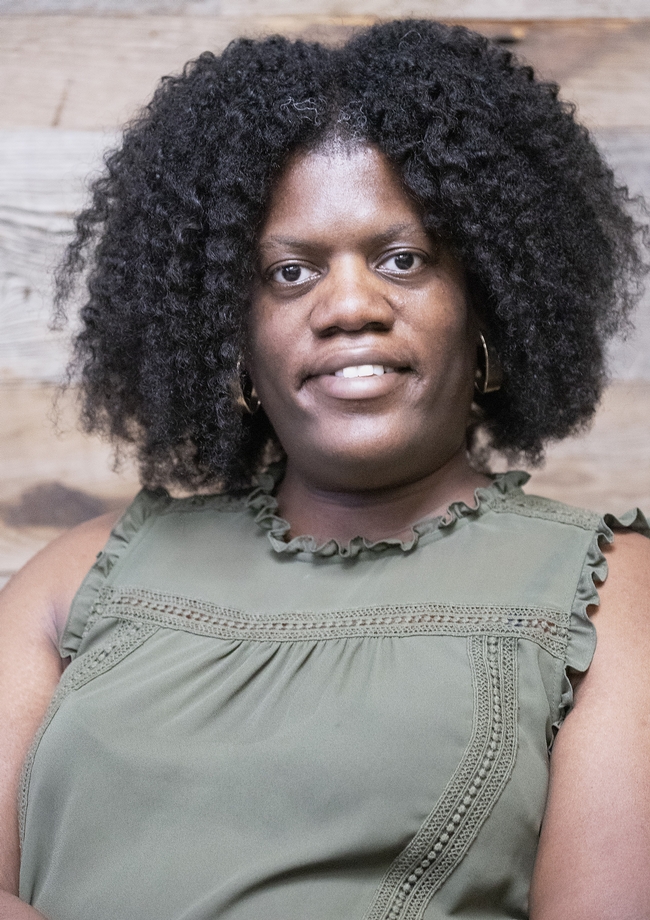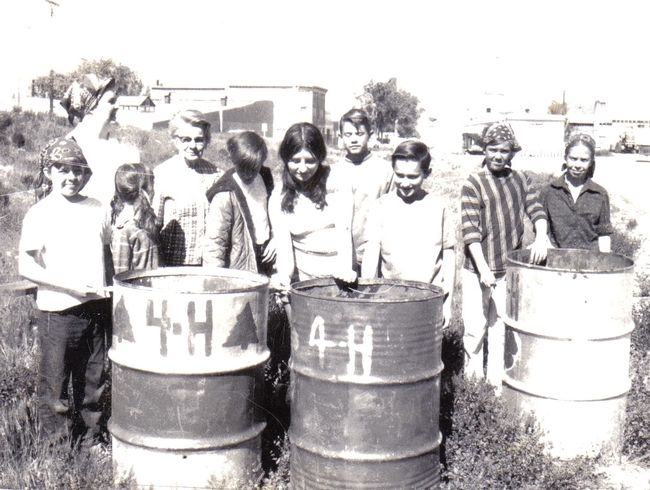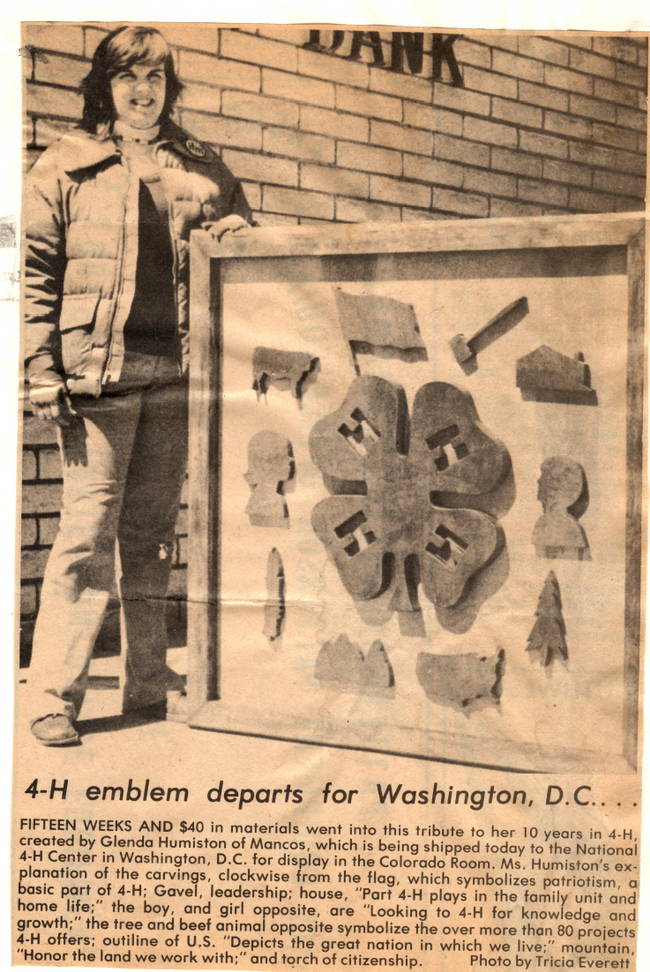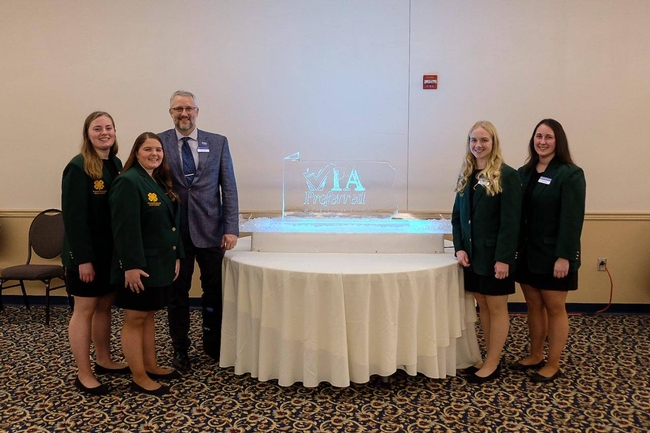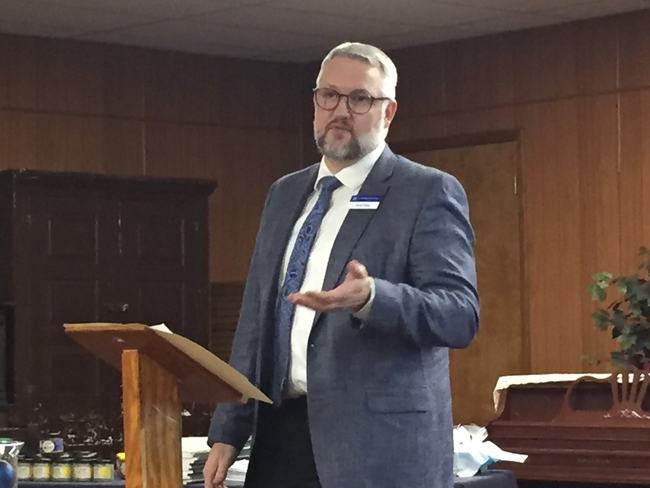- Author: Saoimanu Sope
In celebration of Black History Month
Through music, movies and other media, many people know about Compton, a city located in southern Los Angeles County. Keith Nathaniel knows it from firsthand experience. Before Nathaniel and his family moved to Compton in the 1970s, the LA Watts Riots of 1965 underscored the tension brewing between law enforcement and the Black community that was felt not just in California but nationwide.
“Before we moved, Compton was changing from a predominantly White city to a Black city. The Watts Riots changed that and suddenly, you've got White flight out of Compton and into the suburbs,” said Nathaniel, UC Cooperative Extension director in Los Angeles County.
Growing up, Nathaniel was surrounded by people who looked like him. “It was a typical community of people who supported each other. The adults knew each other, and the kids knew each other,” he said.
Nathaniel remembers his teachers in elementary and middle school, identifying them as first-generation college students – most of whom graduated from universities following the 1954 civil rights case, Brown vs. Board of Education, which resulted in the desegregation of public schools across the United States.
“Those teachers had this real desire for us to match, if not exceed, their success or level of educational attainment,” said Nathaniel. “They were committed to seeing us become healthy and thriving adults.”
Although Nathaniel and his peers had influential Black leaders in their schools, prioritizing academic success was challenged by the introduction of crack cocaine. “With drugs came influx of gangs. Then, you start to see the community become unstable because gangs want to control this block or that corner,” Nathaniel said.
“We used to have shootouts at our high school. But it was Black and Brown lives being affected so it wasn't newsworthy in that sense. Not like today where you see an epidemic of school shootings making the news. This was happening back in the day, too,” he said, emphasizing that he and his peers were constantly reminded to be cautious while out at social events in the community.
“It was scary to think that you could be mistaken for being in a gang even if you had no ties.”
Students that were once friends in elementary or middle school became enemies by the time they started high school. Although Black boys were highly favored as gang recruits, Nathaniel said that his strong family foundation and focus on academics kept him out of the crossfire that others stepped into.
After graduating from high school, Nathaniel started college at UC Davis, where he pivoted to sociology after realizing that engineering was not for him. “I intended to graduate with a degree in engineering, but it was so competitive. I was in classes with pre-med students, and they were jacking up the grading curve,” he joked.
What Nathaniel did not realize prior to college, however, is that academic aptitude would not be the most important aspect of his experience in education. It was also the connections and relationships he built with others. Reflecting on the five years he spent at UC Davis, Nathaniel said that it was the best five years of his young adulthood.
Grateful for the teachers and advisors that kept him grounded, Nathaniel decided he wanted to become a teacher himself. From Davis, he pressed on for his master's degree at Florida A&M University where he studied educational leadership. Despite his high school advisor discouraging Black students from attending a historically Black university or college, Nathaniel felt the urge to do just that.
“My advisor was just incredible. Her goal was to get everyone to college,” said Nathaniel. “But she didn't like the idea of us going to an HBCU because it's not how the real world looks. She would tell us that it's better for us to integrate ourselves on campuses that reflect the world we live in.”
During graduate school, Nathaniel's mother died, and he returned to California. Although his loss led him to believe that returning to school was not ideal at the time, Nathaniel said that his professors reached out to him while he was away, and their concern swayed him.
“They checked up on me and it made me realize how much support I had back in Florida. I'm pretty sure this wouldn't have been the case if I wasn't attending an HBCU,” Nathaniel said.
He went back to Florida to finish what he started. While earning a master's degree, Nathaniel said he was encouraged to pursue a doctorate degree and he seriously considered it, but not immediately. By then, his vision evolved into becoming a principal or superintendent and expanding his influence beyond the classroom. “I wanted a seat at the table, but I knew that I needed the credentials first,” he said.
Upon returning to California, Nathaniel applied for teaching positions and stumbled upon an ad in the Los Angeles Times seeking applications for a 4-H program coordinator. He was not offered the position he applied for, but he was offered a coordinator role for the Americorp/VISTA volunteer program instead and willingly accepted.
Since 1994, Nathaniel has been a part of UC Cooperative Extension and started out by managing the Americorp/VISTA volunteers who were responsible for introducing the 4-H program to communities across Los Angeles. The program grew quickly, engaging 4,000 to 5,000 kids daily. The power of the program was not just in its passionate volunteers, but the fact that the volunteers lived in the communities they served.
Prior to 4-H, Nathaniel worked for the Campfire Council and was introduced to informal education such as teaching youth in life skills and connecting with them outside of the traditional classroom. This experience served Nathaniel well as he transitioned into 4-H, inspiring him to pivot from his original goal of working in the formal K-12 system.
In 1997, Nathaniel was accepted to UCLA where he earned a doctorate of education while working full-time. “Going back to that seat at the table… by this time in my career, I knew that I wanted to influence policy that would benefit young people. I wanted to do more than teach. And I also knew that I needed the credentials to do it,” said Nathaniel.
Now, Nathaniel enters his 30th year of service to the community through UC Cooperative Extension. Realizing how far he has come, Nathaniel said that the adversity of his childhood helped build his character and prepared him for the battles ahead.
Emphasizing the significance of connecting with people, Nathaniel said that it is fulfilling to serve the community that raised him and credits the mentors and peers he has met along the way for his triumphs.
“If we surround ourselves with people that have our best interest in mind, we'd believe that we're going places,” he said. “It's about being selfless, too. So that we can help others see themselves the way we see them; so they feel empowered to do whatever it is they want to do. That's what I had, and that's what I hope to give back.”
- Author: Saoimanu Sope
In celebration of Black History Month
When she was younger, Tamekia Wilkins believed that becoming a movie star was her calling. “Then reality sank in, and I knew that wasn't going to happen,” said Wilkins, an evaluation coordinator based at UC Agriculture and Natural Resources headquarters in Davis.
Her path forward focused on becoming a psychologist instead.
“I had this vision of helping people, but doing it while they were sitting on my couch, telling me about their troubles,” she said. Originally from Tuscaloosa, Alabama, Wilkins earned a bachelor's degree in psychology from the University of Alabama. Although she was set on psychology, Wilkins experienced a shift along the way – most of which was shaped by questions of identity and race.
Thinking back to the place and people that raised her, Wilkins said she had a good childhood. “I spent my days outside playing with friends. We'd play freeze tag, hide and seek… you know, normal stuff,” she said.
Wilkins grew up in Alabama during the 1980s and '90s. Her parents, however, endured the racial discrimination and segregation that catapulted the civil rights movement during the mid 1950s to late 1960s. Alabama has and always will be home for Wilkins and her family, especially her parents who live in the same house she grew up in, to this day.
For Wilkins and her three older siblings – two sisters and a brother – conversation about race and identity was a regular topic in their home. “My parents did not shy away from talking about our Blackness and race relations in this country,” said Wilkins. “It was a good thing, because it prepared us to have these conversations outside of the home, too.”
Despite only having high school diplomas due to circumstances, Wilkins' parents advocated for higher education. “They told us that if we went to college, life would be easier; they wanted us to do better than they were able to,” Wilkins said.
After completing her bachelor's degree, Wilkins packed up her stuff and left the only place she had ever known. She moved to Illinois to pursue a doctorate, getting her master's degree along the way.
As a master's student at the University of Illinois at Urbana-Champaign, Wilkins studied human and community development. She was primarily interested in understanding the influence parents have on elementary school children's behavior in the classroom, based on their level of involvement. Her interests led to opportunities to learn how to conduct quantitative research, design surveys and use software for statistical analysis.
With her new skills and research-focused mindset, Wilkins completed her dissertation on the influence of racial socialization on children's academic performance and behavior during the early school years. “I wanted to understand internalized behavior, and investigate the how and what parents say about race and its effects on their children in different areas of life,” Wilkins said.
The data collected revealed that Black parents living in predominantly white neighborhoods were more likely to engage in racial socialization compared to those living in neighborhoods where the racial makeup was more diverse or predominantly Black.
“What I learned is that when you live in a community with others who look like you, you don't have to be as intentional all the time,” said Wilkins. “The racial makeup of elementary schools tends to resemble the communities they are located in. So, Black parents are more likely to have conversations about identity when their children are going to predominantly White schools.”
Wilkins surprised herself throughout her educational journey. Earning a Ph.D. was not a solid part of her life plan, but she is grateful that it all happened the way it did, noting some influential mentors along the way. “I had a mentor during grad school, Christy Lleras, whose research, even today, is based on social justice issues and inequity within education. She was my cheerleader and was always on board with everything I wanted to do,” said Wilkins.
Robin Jarrett, another mentor, was the only Black professor in Wilkins' department during the time she was a student. “Even though she wasn't my advisor, she was certainly a mentor with so much wisdom. We keep in touch to this day and sometimes I'll call her up and let her know what's going on in my life,” she added.
Today, Wilkins applies her research skills to her current role as an evaluation coordinator analyzing data for three UC ANR statewide programs: 4-H, UC Master Gardeners, and the Expanded Food and Nutrition Education Program (EFNEP).
“I never thought I would find myself in California,” said Wilkins. “Coming from Alabama, California always seemed like this ‘other place' that was way too expensive to live in.”
Fast forward to 2016, shortly after graduating with her Ph.D., Wilkins moved to Sacramento to begin working for UC ANR and has been supporting the same programs for eight years now. Despite living in California and being a lot closer to Hollywood, Wilkins admits that her dream of becoming a movie star remains in the past.
These days, she is more eager to take advantage of California's natural beauty and landscapes. “In the eight years that I've lived here, I have not done enough things. I need to do more exploration,” she said.
When asked about her success and the trajectory of her journey thus far, Wilkins said that having a growth mindset is number one. “I've always believed that I could accomplish whatever I set my mind to because I have a growth mindset. After that? You've just got to do the best you can. Always do the best you can!”
- Author: Mike Hsu
If you're on a video call with Glenda Humiston when she's in her home office, you'll see the sign right above her left shoulder, prominently displayed: “4-H CLUB MEMBER LIVES HERE.”
It's the same sign that hung on her childhood home in Mancos, Colorado, in the remote southwest corner of the state. And the sign is a symbol of the influential role 4-H has played in the life and career path of Humiston, University of California's vice president for agriculture and natural resources.
“I asked if I could have it, and my dad was like, ‘Yeah, sure, I think it belongs with you' – which really annoyed my sisters, quite frankly,” she said with a laugh. “But I love having it.”
Humiston – and all four of her younger sisters – were active in 4-H during the late 1960s and 1970s. Joining the Mancos club as soon as she was able to, at roughly nine years of age, Humiston participated through high school. She even did collegiate 4-H at Colorado State University.
For National 4-H Week (Oct. 1–7), Humiston – who leads UC Agriculture and Natural Resources, the umbrella organization under which California 4-H operates – sat down for an interview about the profound impact of 4-H on her life.
You started out by showing dairy cattle and beef cattle, but you quickly broadened the scope of your 4-H experience. What else did you do in 4-H?
I did a lot of projects, not just showing the livestock – I did veterinary sciences; I did demonstration talks; I did conservation; I did woodworking. In fact, I got Reserve Grand Champion at the Colorado State Fair in woodworking one year. I made a tack box for showing livestock; I did some inlaid imagery in it. I also did a nice piece that I donated to the National 4-H Center in D.C. that, for many years, was their big artwork in the lobby that you see when you enter. [See photo at right.]
I also really enjoyed public speaking; I competed in that. Part of that was strategic – everybody turns in beef or something like that, and not very many kids were doing record books on public speaking, so I thought it gave me better odds. [Record books are kept by 4-H participants to document their progress on a project and can be submitted for competitions.]
I actually have one of my speeches about being an environmentalist when I was quite young. A little ahead of my time there. My mother said I was a very preachy child – and that was one of the times that I was!
Of the many wonderful experiences you had, what are some of your favorite aspects and memories of 4-H?
I really love the record book. I think that's one of the things about 4-H that makes it different than a lot of other youth programs. We were taught to keep a record – particularly important for showing market animals – including accounting and keeping our books: like how much did we spend on that animal and on feed and equipment. At a young age, you're learning a lot of life skills that way.
And things like the community engagement, the public speaking, these are all important skills that you just don't get unless you're out there actually doing something with it. Sitting in a classroom is not the same.
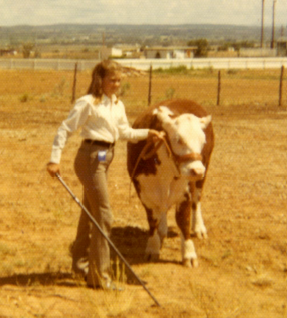
How did 4-H open your eyes to the possibility of college?
As a young person, I wasn't even thinking about college so much – I like to say that one of the reasons I even thought about going to college was 4-H, because we used to go to the Colorado State University campus in the summer for the state 4-H conference. Staying in the dorms, wandering around the campus and having the meetings there – meeting kids from all over the state – it made me feel like, “Wow, I could do this!”
I'm the first one in my family ever to go to college, and there just wasn't anybody in the family to talk about what that involved or what it looked like or anything.
That's why nowadays I think our “Juntos” program is so important. I love that we take Latino kids to a UC campus. I think the numbers I've seen are at the beginning of the week, something like 20% of them think they might go to college, and at the end of the week it's jumped to something like 80 or 90%. It makes a big difference, having the chance to see and feel.
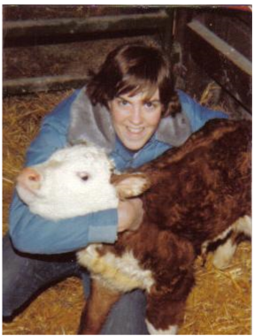
How have you seen 4-H evolve and change, and how will it continue to adapt to the times?
I love the fact that we're doing these SPIN clubs – these special projects that are a little shorter term. I think that's a great evolution. Not every family in this day and age can sign up for the whole-year, club program. That's a lot for parents to take on being volunteers and project leaders.
Having the in-school and after-school options and six-week and nine-week options opens it up to a lot more kids. And frankly if we can get them interested in the short-term special projects, then maybe they will join the club program.
I love the fact, too, that 4-H really tries to be inclusive. 4-H has really been always very inclusive; I actually was invited to be a keynote speaker at a conference in Ohio – at The Ohio State University – about four years ago. Several states got together to talk about LGBTQ 4-H kids and youth, what were the challenges they were facing and how we were serving them. I thought it was fantastic that Ohio State and these other universities put on that event; conversations were mostly about making sure those youth felt safe participating in 4-H. It's vital that we all strive to ensure that 4-H is for everybody.
Now we would like to hear from you, 4-Hers! Tell us how 4-H has made an impact in your life, and share a favorite memory or two, by posting in the Comments box at the bottom of this story.
- Author: Mike Hsu
Between 4th and 8th grade, Brent Hales had acquired from those years in 4-H a lifetime's worth of skills, a group of lifelong friends, an expanded perspective on the world – and the track suit of his dreams.
The middle child of seven kids, young Brent knew his family couldn't afford to buy a track suit off the rack. So he saved up money, bought the Navy blue fabric and pattern, and took on sewing as one of his many 4-H projects during the 1980s. Just one problem: he ended up making it inside-out, with the fuzzy side facing outward.
“And then, by the time I actually completed it, I had outgrown it, so I gave it to my younger brother,” Hales recalled with a laugh.
Hales still enjoys sewing, although he rarely finds time for it, given his many duties as UC Agriculture and Natural Resources' associate vice president for research and Cooperative Extension.
One of his responsibilities is helping to oversee the 4-H program in California, which, along with its counterparts across the country, is celebrating National 4-H Week Oct. 1–7. In a recent interview, Hales shared some of his favorite experiences as a 4-H club member growing up in Aurora, Utah, as well as some of the enduring impacts from his participation.
The mere mention of 4-H must bring back a torrent of memories, images and stories. Can you share one experience that stands out for you?
At the end of the summers, the leader of our horse club, Dan Thompson, would take us on a weeklong horse ride. In order to qualify, you had to demonstrate horsemanship, you had to be able to take care of your horse, and show a certain amount of leadership.
Dan had the kids take the lead; he planned the route but then he would ride in the back. Each day of the horse ride, we would take turns at various aspects of leadership within the week. We would get to a point and we would discuss where we were going; we would discuss points along the trail that we needed to be looking for. But, invariably, all with him in the back, allowing us to lead. He wanted us to lead the whole thing.
You could imagine sending a group of 11-, 12-, 13-year-old kids on a weeklong horse ride with a guy would be daunting enough. But the most important thing you need to understand is the amount of trust that we had in him, he had in us, and our parents had in him – because Dan was blind.
He had gone blind late in life. He knew the trails well enough that he could describe what we were going to see, and he could describe where we were going to stay, but he left it up to us to share information and lead.
You think about the types of skills that it taught us – I have cold chills thinking about that – and the confidence that it instilled in us was so powerful. In a community where less than half of the kids went on to a four-year degree program, all 11 of us in the horse club completed four-year degrees, and all of us are continuing to be very successful.
In addition to leadership skills, public-speaking skills, sewing skills and horsemanship…what else did 4-H teach you?
We actually got involved quite a bit in the arts – the visual arts, the performing arts. Because of that, I went to college on a vocal performance scholarship, which I tie right back to 4-H.
We put on an annual musical at the county fair, which translated to being involved in musicals at school and other performing groups. It paved the way for me to go to a much better school than probably was in my academic trajectory otherwise, so I went to BYU as an undergrad.
I realized very quickly how out-classed I was in terms of the vocal performance and ultimately changed majors – but I stayed involved and had the opportunity to do quite a bit of traveling and touring with various musical groups. In the last three years, I've sang at both Carnegie Hall and the Kennedy Center, as part of ensembles and groups. What a long tail my 4-H involvement has had, in encouraging my love of music and of performing!
In what other ways did 4-H shape who you are today, personally and in your career trajectory?
My hometown of Aurora was settled by my fourth great-grandfather, so I was actually related to about 85% of that small town. And so I had a very myopic view of what the world looked like.
What 4-H did was it showed me that there's a much larger world out there. Because of 4-H, I engaged with different kids from different backgrounds, different ideologies, different life expectations than that of my own. And it opened a world I never knew existed, number one, and that I had a place in that world.
So the thought of moving from my safe, rural community…when I was a little kid, that was the last thing that I wanted. But after engaging with kids from not just across Utah, not just across the country, but across the world, it created a hunger in me to learn and to know and to experience. And that has yet to be satisfied!
Every time I remember and relive my 4-H years, I'm reminded of why I do this job – to enable others, perhaps, to be that kid that I was, and see beyond what their worldview is, or the limitations of their culture, identity and hometown.
On top of your 4-H role as a part of the leadership team at UC ANR, you're also on the strategic planning board for the national 4-H organization. How has 4-H continued to evolve over the years?
With COVID, when I was at Penn State, we shifted online and we saw a whole new generation of kids who would not have ever joined 4-H as a result. We created statewide programs, instead of the traditional clubs, and that brought together kids who normally would not have been drawn to it. And instead of meeting face-to-face, we met virtually and we sent out activity boxes ahead of time. Then, post-COVID, what surprised us is that the online clubs – the clubs we kind of anticipated going away – those actually continued to grow.
So how we reach the kids has evolved as much as the type of kids that we are seeing come in. And it has had to – if we marketed 4-H to an ever-shrinking rural population of on-farm kids, it would quickly become irrelevant. And so the way we market to them, the way we bring them in, the way we encourage and facilitate discussion, the way topics and areas of interest are identified – those continue to evolve and I hope will drive the next iteration of what 4-H looks like. Because it doesn't look anything like what I grew up with – granted, that was a long time ago, over 40 years ago! And I would say in 10 years 4-H probably won't look like what it looks like now. And that's a good thing.


